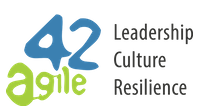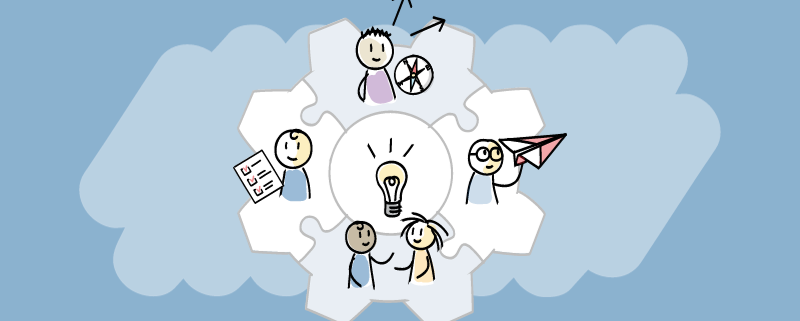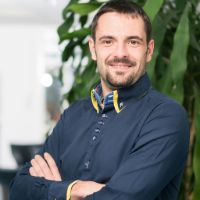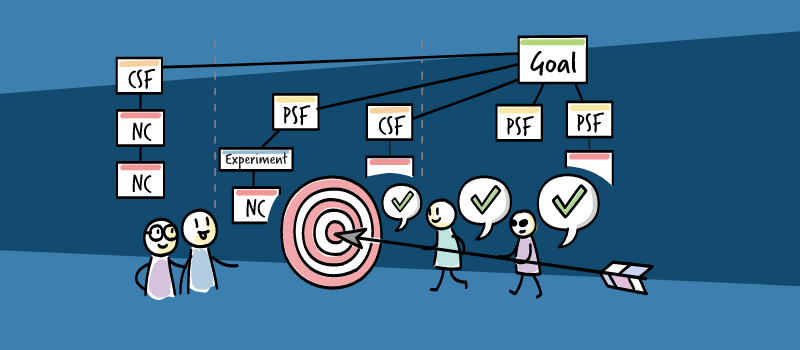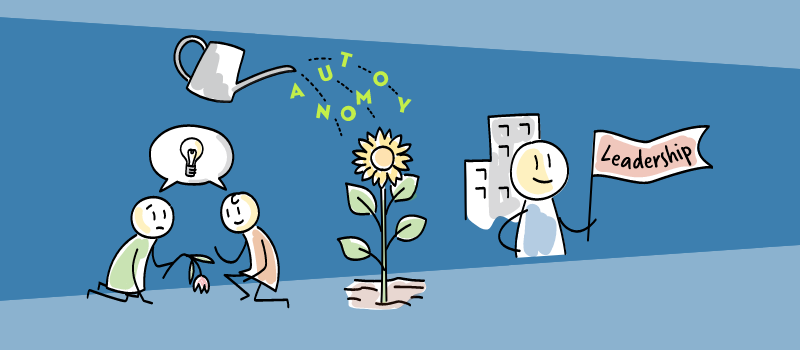Case Study: How to Approach an Innovative Culture
Abstract: Flexibility and the ability to make decentralized decisions, as well as a high degree of customer orientation, are core elements of an innovative culture. In addition to specific leadership behaviors, to be able to sustain an innovative culture you need to develop a dedicated toolbox. A project team at Siemens Digital Industries – Factory Automation – was able to lay the foundation for a customer-centric development of new products through a holistic leadership approach. The principles of ORGANIC agility® and the use of specific tools for innovative product development allowed them to verify product hypotheses rapidly and reflect those learnings into their business strategy.
The increasing automation and digitalization in the manufacturing industry – often associated with the buzzword “Industry 4.0” – heralds a further transformation in industrial production. The change is taking place gradually and is driven by the constant further development of technologies and their spread.
One of the key challenges for many companies is to balance their product portfolio. A balanced portfolio is composed of two essential segments: an exploit portfolio, which comprises the products that are driving a company’s current commercial success; and an explore portfolio, which comprises innovative products and technologies whose commercial viability still needs to be validated.
“The responsibility of product portfolio management at Siemens is not just to have a balance between products in early and mature phases of the life cycle. Rather, we also have to consider what we base success on in the different phases and how we deal with these differences. The outside-in-perspective has helped us to better understand core elements of the different phases of product development. By actively working on the appropriate culture and leadership behavior, we have been able to better understand our customers’ needs, and thereby meet the needs of the early phases of product development. That allowed us to bring a new product to market faster than we have managed in any comparable initiatives.”
– Christian Röttenbacher, Ph.D (Siemens Product Portfolio Manager)
The needs of product development and stakeholders differ fundamentally depending on the maturity of the product. In early phases, product ideas must first and foremost be validated by potential customers. This helps organizations to understand whether an idea can be implemented and informs them about the broadest possible market. A competitive business model is created when the corresponding hypotheses on “desirability, feasibility and viability” can be quickly validated.
In contrast, established products in more mature stages have to deal with other market needs: increasing competition creates cost pressure; product portfolios have to be differentiated to serve specific niches. The standardization of products also means that quality is an important differentiating factor.
Keeping these two types of products in balance requires a high degree of organizational resilience. Often, this results in different teams and subteams having quite different cultures, even within the same company. Every organization needs to cope with the existence of these “subcultures”, while both exploiting existing products and exploring new ones. This can cause cultural friction. In order to handle this, the Siemens business unit “Factory Automation” set up a corporate venture.
The specificity of explorative work
The differences in an explorative way of working can be seen in both behavior and objectives. There is obviously a strong link between the products themselves and the structure of the organization delivering them. The nature of requirements changes along the lifecycle, and the organizational structure is required to adjust over time to accommodate this. There are different ways in which an organization may adjust.
A clear separation of research, pre-development, and serial development supports clear and dedicated goals and provides stability within the organization. However, this comes with the cost of handovers and it can hinder end-to-end ownership. In order to ensure this end-to-end ownership over time, managers and employees have to focus on the specific needs of the particular phase within the product life cycle. This requires cultural awareness and coherence.
Cultural coherence provides a shared understanding of how situations are interpreted. It grows over time and can be strengthened through joint reflection and a clear and shared purpose. It supports cohesion and helps to increase their impact and collaboration.
“In the context of this project, it was particularly important for us to involve employees throughout the entire process, give them responsibility, and grow product ownership at an early stage. This high degree of ownership helped us to form a powerful and self-organized team out of motivated individuals.”
– Alexander Hausner, Project Manager
If developers have worked in series production for a long time, it is an adjustment for them when they are suddenly confronted with ‘good enough’ as feedback. This represents a significant difference between innovation, where you need to be fast and validate prototypes frequently, and serial production, where you focus primarily on stability, durability and long-lasting sustainable quality. Balancing this becomes a major challenge to teams and leadership:
“Working previously with other internal startups, we learned how important it is for a culture to be allowed to develop independently. For me as a manager, it was important to be able to set a mission statement with clear guardrails on one side, while allowing the teams to carve a certain amount of freedom for themselves, on the other.“
– Alexander Hausner, Project Manager
The design and development of the organization was based on the principles of ORGANIC agility®. The framework offers organizations a structured approach to transformation and thereby helps them to find their way towards becoming more Agile. ORGANIC agility® does not provide a concrete process model for product development nor define a target organization. Rather, it allows organizations to reflect on their own orientation in terms of culture, strategy, or value creation and to adapt to the respective context quickly and purposefully while taking into account the existing capabilities of the teams.
Organizations are multi-layered and complex. The greatest challenge in establishing a completely new value stream lies in its validation. This process begins with a value stream discovery, in the course of which, among other things, new personas and new target groups are developed and validated. At the end of the day, the goal is to validate an entirely new business model. In this specific case, the venture focused in particular on two principles of the ORGANIC agility® framework: “Focus on Value Creation” & “Validate Change in Small Increments”.
“As Agile Coaches, it is our responsibility to provide our clients with some guidance and support in dealing with frameworks that are new to them. Our efforts are most sustainable when groups can build on our input and take responsibility for their own product and organization.”
– Lothar Fischmann, Agile Coach, agile42
In addition to a framework for product and organizational development, a product vision is also essential to support and provide orientation in these early stages. A product vision not only serves to motivate and strengthen the sense of belonging, but also supports decision-making.
“As we had a clear mandate to drive innovation there were a couple of difficult decisions already at the very early stages. At a first glance, that sounds very vague, but if you want to pursue concrete ideas or demonstrate results, you have to focus on concrete technologies or markets. In this case, focusing on one market also means deciding – at least for the time being – against another”
– Christian Röttenbacher, Ph.D (Siemens Product Portfolio Manager)
Continuously sharing and repeating the product vision also supports teams and organizations in decentralized decision-making and is therefore a core element of lateral leadership. Knowing the target direction encourages employees to make decisions more autonomously, following the right intent. A common goal makes a project’s progress more tangible, as “quick wins” and incremental growth can be achieved. In early phases prototypes become a very effective way to express this progress. This is where innovative environments differ from later phases of the product life cycle, where efficiency becomes more important.
“The quick validation of customer needs has allowed us to verify if we were on the right track. Regular reviews and demos of our prototypes every two to a maximum of four weeks led to quick learning cycles. This experience influenced our system architecture, development processes and requirements. This allowed us to do quick course corrections, no matter how radically new ideas diverged. The rapid learning also had a psychological aspect: team members understood and accepted the importance of early validation of short-term goals. Building something simple that may be thrown away later, is key. As in nature, where flawed designs have no place, outdated concepts must also be displaced by suitable new ones. This happens in an evidence-based manner and continuously. This is what I understand as ORGANIC agility®.”
– Alexander Friedemann, Product Owner
How to pursue goals in infinite space
Having “innovation” as the only agenda provides sufficient freedom and space for creativity. Even if this sounds attractive, people may get lost without any orientation and goals to pursue. In order to make the context of the project more tangible and to be able to define progress, the team identified a number of vectors that helped the team to discuss which wheel should be reinvented first.
Vectors such as “technology”, “users”, “markets,” or “industries” made it possible to create a common narrative and concrete hypotheses that the teams wanted to understand. Narratives and product hypotheses also made it possible to expand the venture and include additional teams from the People’s Republic of China. A joint narrative can support individuals’ motivation but also let them understand the project’s intent. This becomes important if many people are required to solve complex problems and it helps them to make decisions in a joint and aligned direction. Besides having a shared vision, shared responsibility and ownership, shared rituals are important to help shape individuals into a team. The demos provided a special incentive for the teams and had an important integrative aspect. Although the teams were never able to physically see each other due to the Coronavirus pandemic, the shared sense of achievement constantly strengthened cohesion.
“When you experience writing something in a command line and 7,500 kilometers away a prototype becomes alive, that’s something great.”
– (Felix Lösch, Software Developer)
Use of hackathons and Design Sprints to validate progress
One of the greatest challenges in the early stage of a new product or a new value stream is the rapid and continuous validation of product hypotheses. In the development of a new business model, a distinction must be made between desirability, feasibility and viability:
- Desirability: What is the specific customer need?
- Feasibility: (How) is the idea technically feasible?
- Viability: Is the solution financially viable?
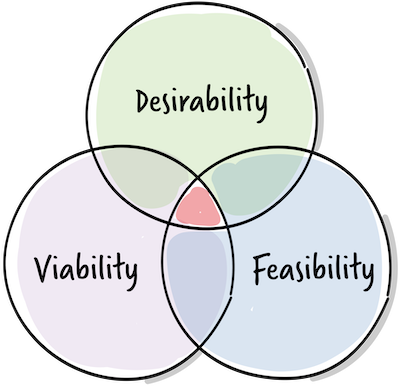
Several “Potential Success Factors” (PSFs) can be defined for each of these aspects which together may become a business model. If PSFs are validated by experiments, they pay off as Confirmed Success Factors (CSFs) towards the strategic goal of an organization. A Strategy Map can be used to gain visibility on PSFs, CSFs, experiments, and Necessary Conditions (NCs) and map their progress.
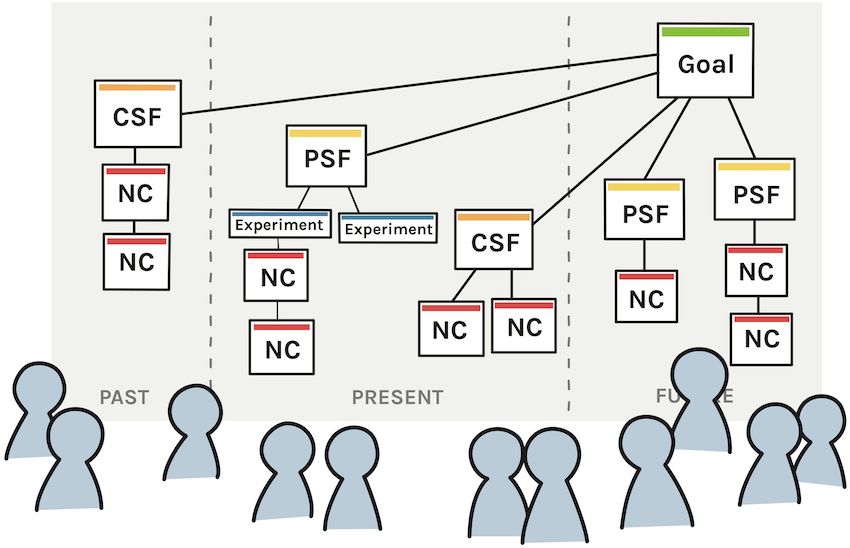
The early and regular delivery and validation of products’ increments is a core element of Agile and can be found in the principles of the Agile Manifesto. In order to do so there are different approaches and techniques that can be found in practice. For example:
- XP sees the customer as a part of the development team;
- Scrum teams use recurring Reviews to demonstrate progress and obtain feedback on a growing increment;
- Design Thinking incorporates potential users in qualitative interviews or observations on the job, finding insights by analyzing the gathered data and testing prototypes to understand what exactly a customer desires; or
- Hackathons provide single or multiple prototypes that contrast different technical ways to serve a requirement.
A Design Sprint is a process developed by Google Ventures that combines the principles of
Design Thinking, business strategy, behavioral science, and innovation this maps them into five phases. When groups use this process correctly, it enables the definition of innovative product hypotheses, as well as their immediate validation or falsification. One of the key benefits of a Design Sprint is that it enables groups to articulate and prove a hypothesis on an idea’s desirability in a short period of time. Both validated and falsified hypotheses enable us to focus and prioritize the most promising product ideas. This sharpens a team’s or even a value stream’s guardrails. The better the customer’s needs are understood, the more likely it is that innovative, desirable products will emerge.
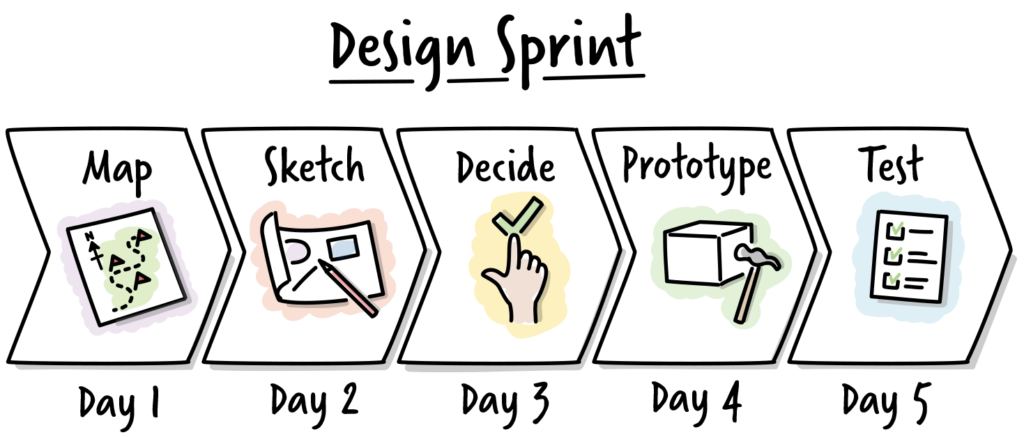
“Design Sprints helped us, for example, to hit the industry focus points and validate them immediately. Five days is a very short period of time, at our company, to create the basis for decisions on far-reaching topics.”
– Alexander Friedemann, Product Owner
Hackathons are a good opportunity to translate identified needs and characteristics into technical solutions within a few days. They thus validate hypotheses of the “feasibility” of a product. Typically, a large number of development teams, balanced for the achievement of the goal, meet for this purpose and try to implement one or multiple technical prototypes within 48-72 hours. Experts and project partners can be involved upon request.
Both Design Sprints and Hackathons come with a high degree of user-interaction. Dealing with appreciative feedback leads to a strengthening of the ownership in the teams. On the one hand, customer interaction helps to confirm initial interpretations and, on the other hand, it makes it easier for discussions about features and prioritizations to be naturally reasoned from the user’s point of view. This facilitates the prioritization of large, important decisions.
“Since our product can be used stand-alone or as a part of other solutions within the Siemens product portfolio, the short-cycle delivery and validation was also a strong signal to potential internal customers and sponsors.”
– Alexander Hausner, Project Manager
Specific rituals of an innovative culture
Events like Hackathons or Design Sprints were just the very prominent tip of an iceberg. The teams developed a number of their own rituals relatively quickly, which strengthened their identity and collaboration. Typically, innovative environments are characterized by a high degree of personal contact and interpersonal exchange. Solving difficult questions often requires a multidisciplinary approach, meaning that many heads are put together to solve a particular question. How this collaboration is orchestrated is usually decided in a decentralized and flexible manner in innovative cultures.
“Although the project started in the middle of the pandemic, we learned to collaborate remotely to a certain extent – but we quickly realized that the close coordination we needed worked better when we were in the same room. Accordingly, we were back in the office soon after the pandemic subsided and agreed on joint team days when we would be onsite again. At some point this also meant that every employee had to do a COVID-19 test at the beginning of each office day, but this was worth it for us.”
– Alexander Hausner, Project Manager
Decentralized decision- and solution-making allows teams to ensure that outcomes are closely aligned with individual needs of teams or customers. The support of facilitators and Agile coaches can nurture the organizational development and catalyze team building and decision-making by applying a well-sharpened toolkit.
The definition of working agreements may be a good initial starting point for facilitating a decentralized, internally oriented culture. For an externally oriented culture it is necessary that these working agreements support but don’t constrain creativity; an externally oriented, decentralized culture is more interested in innovation and shortening learning cycles. An appropriate toolkit for such environments contains the facilitation of Design Sprints or Hackathons. In further team development, they serve to moderate the ‘storming’ and catalyze the product discovery and development process.
Outcome – where are we today?
Since the main purpose of the new venture was about new product development, the product vision and its joint narrative, mid-term goals, and targets all play an important role. Considering requirements from the customer’s perspective, working on specific use cases and validating them using functional products helps all teams involved and provides direction and orientation. The frequent development of prototypes is the most important expression of goal-accomplishment and plays an important role in the teams’ rituals.
“A prototype is a helpful tool for getting a common understanding of requirements or mapping technical feasibility. But over the last few months, we’ve learned as well how important it can be to let go of a prototype or idea when it becomes obsolete.”
– Alexander Friedemann, Product Owner
The targeted work and design has different effects on the inner life, as well as on the external framework of the project. A joint understanding of constraints that were co-developed and emerged over time helps individuals and teams to keep their focus.
“Mutual trust has led the team to trust colleagues to do more. Jointly designing a framework and working agreements has helped to give everyone involved the safety and self-confidence they need. The experience we gained at an earlier point will continue to support us in the future.”
– Alexander Hausner, Project Manager
Purposeful team development plays an essential role in supporting teams in their development steps, while considering provided project constraints. Short learning cycles and customer-centric development allowed the venture to approach external customers and acquire pilot projects more quickly. This minimizes financial risk and allows the organization to quickly evaluate which solutions have a broader appeal and therefore support the future growth of the product.
“The focused nature of the venture and the ongoing work on culture and leadership have helped us get our new product ideas on the road much faster than in other similar initiatives. Additionally the innovative environment allowed us to make a number of invention disclosures, which we now want to turn into patents. Of course, we can’t say today whether our new product will be successful, but there are a number of leading indicators that point in that direction. And whatever will be, we will certainly find out sooner rather than later.”
– Dr. Christian Röttenbacher, Product Portfolio Manager
Need help with your own cultural transformation?
Reach out to our team to discuss the challenges you’re having, and we can help with workshops, mentoring and coaching, formal training, online short courses, a company-wide Organizational Learning programme, or any combination of these.
Just send us an email at [email protected], or fill out the form, to discuss the challenges you are having and find out how we can help.
